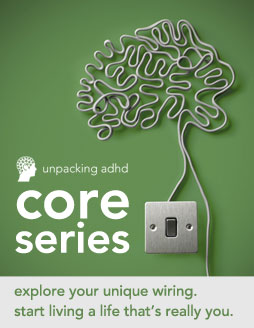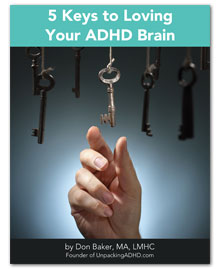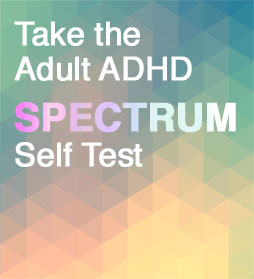Top 10 Adult ADHD Myths

ADHD Myth #1 – ADHD is always a disorder and a disability.
We’re going against the grain on this one. ADHD stands for Attention Deficit/Hyperactivity Disorder. It’s defined as a disorder in the Diagnostic and Statistical Manual of Mental Disorders (DSM-5) published by the American Psychiatric Association. Any clinician will tell you it’s a disorder.
Okay, fine. But the word “disorder” is inherently judgmental, and it doesn’t take into account the many positive traits of ADHD.
Is being empathetic, creative, and enthusiastic a disorder? Is having a rapid intuitive grasp of almost anything you come across a disorder? Is being exceptionally sensitive and curious about life a disorder?
Read more...
“If a left-handed person has a job cutting origami with right-handed scissors, that doesn’t mean they have a disability; they have a context disorder,” says ADHD expert Thom Hartmann. “Short people trying to play basketball have a context disorder.”
ADHD can also be a disability in certain situations, particularly in many school and workplace settings. People with ADHD have the right to reasonable accommodations that enable them to succeed, such as extra time to complete assignments and a workspace without distractions.
There’s a time and a place for everything, but overall we believe that thinking of ADHD as a disorder or a disability is counterproductive to your personal development. People with ADHD are not broken, impaired, diseased, or pathological. We are simply wired differently.
Another key thing to remember is that there’s no way to be 100% sure that you have ADHD. In an effort to legitimize psychiatric disorders, the medical community has tended toward an “all-or-none” model in which a person either definitely does or does not have a psychiatric illness. The truth is that we can’t fully pull apart personality tendencies and brain disorders.
Are you “quite active” or “hyperactive”? Do you have an agile, creative mind or are you pathologically distractible? There’s no blood test to answer these questions. It’s all part of a complex spectrum, a continuum of traits that each individual manifests in his or her own unique way.
“There may be some real benefit from fully accepting a more dimensional view of psychiatric disorders that embraces their relations to temperament and personality,” says David Rettew, MD. “For one, such a perspective might be less stigmatizing. Rather than a person being told that he ‘has’ ADHD, it can feel much more inclusive to be told that everyone lives on this spectrum somewhere and that he is somewhere near the top but he can bring that level down with some intervention and hard work.”
ADHD Myth #2 – ADHD isn’t real.
ADHD is a very real neurobiological difference. Extensive scientific research has proven that people living with the traits of ADHD have chemical differences in the management systems of their brains. Brain imaging techniques such as SPECT, FMRI, and CT have literally shown us that we are “wired” differently.
Read more...
It is true, as we discussed in Myth #1, that ADHD exists on a spectrum and that there’s no medical test to prove that you definitely do or don’t have it. Even medical professionals can only make a judgment call based on your self-reported traits.
What matters is recognizing that the way you uniquely experience the world as a result of your neurobiological wiring is real. If you have ADHD traits, whether or not you have a diagnosis, you can benefit from learning about how to live with these traits more successfully.
ADHD Myth #3 – ADHD isn’t a big deal.
Most people living with ADHD will tell you that their ADHD traits have been a powerful force in their lives — shaping their experience in both negative and positive ways.
Read more...
On the positive side, ADHDers often have big energy, big creativity, and other qualities that can have a big impact on the world. In fact, a lot of “big deal” people in the world have ADHD. People with ADHD traits tend to gravitate toward intense professions: artists, athletes, entrepreneurs, performers, politicians, surgeons, and business leaders.
Some of the many well-known people living with ADHD include actors Jim Carrey, Ryan Gosling, Woody Harrelson, Michelle Rodriguez, and Will Smith; musician Justin Timberlake; business magnate Sir Richard Branson; Pulitzer Prize winning journalist Katherine Ellison; celebrity chef Jamie Oliver; political consultant James Carville; Olympic gold-medalist Michael Phelps; JetBlue founder David Neeleman; Kinko’s founder Paul Orfalea; baseball star Pete Rose; and inventor Dean Kamen.
ADHD Myth #4 – People with ADHD can’t focus on anything.
The name Attention Deficit/Hyperactivity Disorder is tremendously misleading. If you live with ADHD, you don’t actually have a “deficit” of attention. You have plenty of attention and may even be exquisitely sensitive to the sights, sounds, and other details around you.

The challenge is your ability to focus your attention. ADHD wiring means you have limited control over your “mental spotlight,” to borrow a phrase from journalist Jonah Lehrer.
Read more...
But the rest of the time, your attention is probably unstable, easily draw away by competing stimuli. You may feel like you never get to the end of a thought, forget things people just told you, or start many more projects than you finish.
This difference is neurobiological. Particularly interesting or pleasurable activities trigger the release of dopamine, which helps compensate for the dopamine deficit of ADHD and improves attention and motivation. You may also get a dopamine boost when you’re up against a deadline or believe something bad will happen quickly if you don’t accomplish a task immediately.
We’re oversimplifying here, but this is the basic reason why people living with ADHD experience selective attention. They are able to exercise their executive functions very well in certain situations which are unique to each individual, but they are challenged in most other situations. In spite of this, they can still be incredibly successful, especially when they learn to harness their strengths and create more supportive structures and environments for themselves.
ADHD Myth #5 – People with ADHD just need to try harder.
Your brain’s executive functioning is not under your conscious control any more than poor eyesight or erectile dysfunction. Certain situations (as discussed in Myth #4) may override the executive function limitations of ADHD, but you can’t make it happen by internal effort alone.
Read more...
- You just need to develop more willpower.
- You could focus if you really wanted to.
- You’re lazy.
- You don’t care enough.
- Stop messing around and just get it done!
People with ADHD know that they can focus and perform better in some situations than others, so it’s very easy to believe these messages. You may spend a lot of time berating yourself for forgetting things, being late, overreacting emotionally, etc.
The truth is that you can’t fix ADHD with willpower. Most people find that the more they try to push past their challenges by sheer effort, the more they stress themselves out and feel like a failure. A more helpful solution is to focus on your strengths and build on the situations that do engage your attention, while taking the time to understand and accommodate all your ADHD traits.

ADHD Myth #6 – Smart people can overcome ADHD on their own.
ADHD affects people of all intelligences, but people with higher IQs are more likely to fall through the cracks. They’re often able to hide their symptoms from others. They do well enough in school in spite of procrastination, inattention, or other challenges. If they find something they’re passionate about, they can have extremely successful careers. But if their ADHD is never recognized or addressed, they suffer. They need help and support as much as anyone else.
Read more...
Brown’s book explores ADHD in the lives of people who scored within the top 9 percent of the population on IQ tests, but were still stuck. “They sought treatment because they were unable to get themselves out of chronically unproductive, self-defeating patterns of emotions, thought, and action,” he writes. “They felt trapped in their daily dealings with their education, their job, their relationships with others, or a combination of these. Their stories illustrate the persistent difficulties those with ADHD have in managing themselves and their emotions.”
The quote below, from a participant in an Unpacking ADHD group, captures the pain of undiagnosed ADHD and the hope that comes when its impact is finally recognized and addressed.
I’ve had a very successful career and somehow am able to hide my ADHD symptoms from the world. But the cost has been huge. Once I was diagnosed with ADHD, I realized how lonely I am and how little self acceptance I have. With support from others on the Unpacking ADHD journey, both my level of awareness and acceptance have drastically improved. I’m learning to be the real me in the world. ~ Patti Q.
ADHD Myth #7 – Medication can cure ADHD.
Medications for ADHD cure nothing, but they can help. For about 80% of those diagnosed with ADHD, prescribed medications can significantly help with managing problematic traits. Many experts compare taking medications for ADHD to wearing glasses for vision problems. The effect is temporary. You have to keep taking the meds consistently to get the benefits, just like you have to wear your glasses to see clearly.
Unlike glasses, ADHD medications rarely offer a complete “20/20” solution. Learning to thrive with ADHD may include finding the right mix and balance of medications, but you can also benefit from education, support, counseling, and/or lifestyle changes.
Read more...
“Translating ADHD medication theory into effective what-you-do-in-the office, step-by-step guidelines remains downright elusive,” says Dr. Charles Parker, author of New ADHD Medication Rules. “Even the most informed observer recognizes that no rule book exists that sets clear treatment options, clear objectives, and specific outcome measures.”
The personal experience of Unpacking ADHD founder Don Baker provides a bit of perspective:
My first attempt to take medication didn’t work at all. For ten years, I had to rely on strict regulation of diet, sleep, and other self-care to manage my ADHD challenges. But then when I tried medication again, it was amazingly helpful. It doesn’t cure my ADHD, but now I find myself doing stuff I hate to do!
Your experience will be different. But if you do decide to try medication, be sure to work with a clinical provider who really knows ADHD and is up-to-date on current prescriptions.
ADHD Myth #8 – ADHD only occurs in children.
Over the past 20 years, diagnosis of adults with ADHD has increased. We know for certain that adults can experience ADHD. However, there is no such thing as adult-onset ADHD. The fact is that children with ADHD wiring often continue to have ADHD traits when they grow up.

Read more...
Nobody knows how many children are undiagnosed, or how many adults have struggled all their lives with unrecognized ADHD. A 2006 Harvard study funded by the National Institute of Mental Health estimated that 4.4% of American adults ages 18-44 experience ADHD symptoms. The true prevalence may be considerably higher.
Many adults learn they have ADHD after one of their children is diagnosed, or when they seek help for a related problem like anxiety or depression.
ADHD Myth #9 – Adult ADHD is caused by information overload.
You may have heard the notion that “everybody has ADHD now” because of our fast-paced, modern lifestyle. It’s all Facebook’s fault! How can anyone focus when we’re bombarded with information and stimuli every minute of the day?
Certainly the information age tends to create a hostile environment for most human brains, but it can’t cause ADHD.
Read more...
Real ADHD is caused by fundamentally different neurobiology. Underactive functioning in the management system of the brain causes people living with ADHD to have difficulty prioritizing and sorting through stimuli. They are both more sensitive to stimuli and less able to process that stimuli efficiently. There is much more to it, but the bottom line is that ADHD cannot be caused by environmental factors alone, though it can be helped or made worse by such factors.
ADHD Myth #10 – Everyone with ADHD is hyperactive (and most of them are male).
Hyperactivity tends to be the most visible trait experienced by some people with ADHD. The stereotypical image is of little boys who are “bouncing off the walls.” But not everyone living with ADHD is hyperactive. Some just have challenges related to attention, focus, and/or impulsivity.
This is an area where gender plays a significant role. Girls and women who live with ADHD tend to have lower rates of hyperactivity, but higher rates of depression and anxiety related to their ADHD traits. The latest research shows that women are just as likely to have ADHD as men, but they are much more likely to go undiagnosed.
Read more...
“The most common diagnosis of a woman before she receives her ADD diagnosis is depression,” says Kathleen Nadeau, PhD. “So many women have come in to my office and said, ‘I’ve been in therapy for years and I’ve been diagnosed with anxiety and depression, but I am still having problems.’ It’s maddening, and it’s such a treatable disorder. There’s no excuse for that.”
Women are much less likely to have their ADHD recognized during childhood, and many continue to suffer in silence as adults. “The pressure on women to be organized, self-controlled, to be the one who’s keeping everybody else organized, is a societal expectation that’s very deeply ingrained,” says Nadeau.



